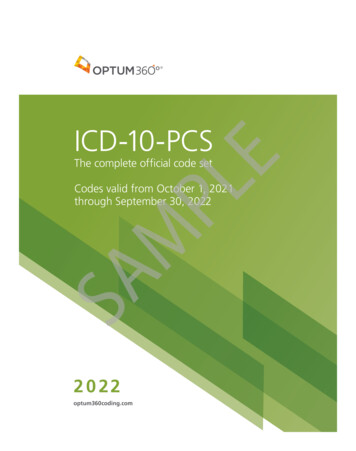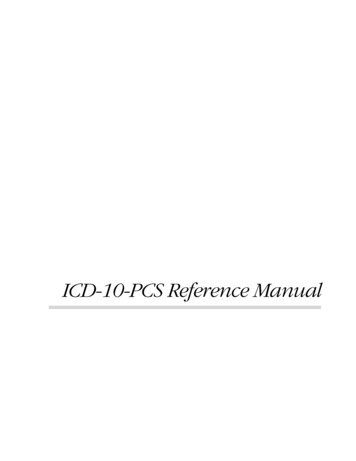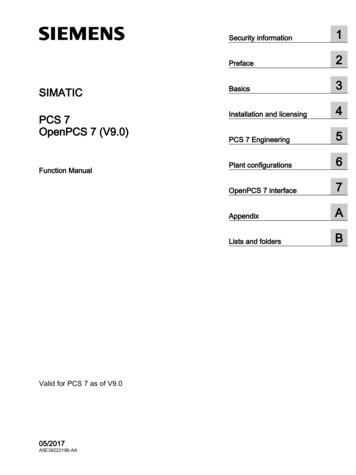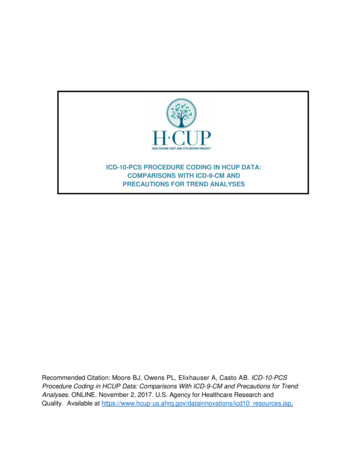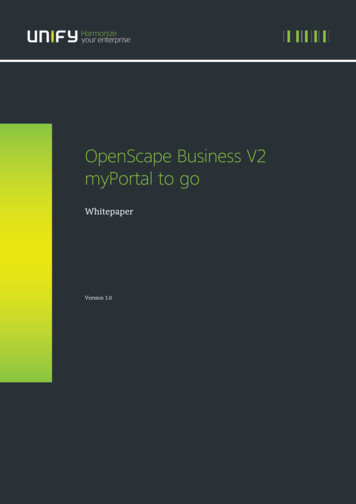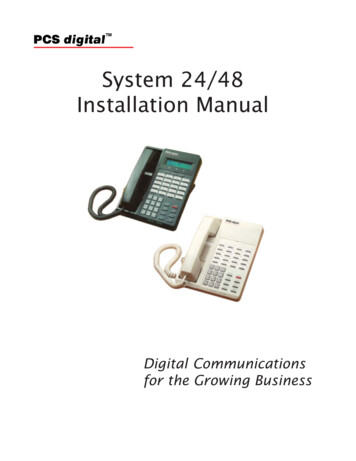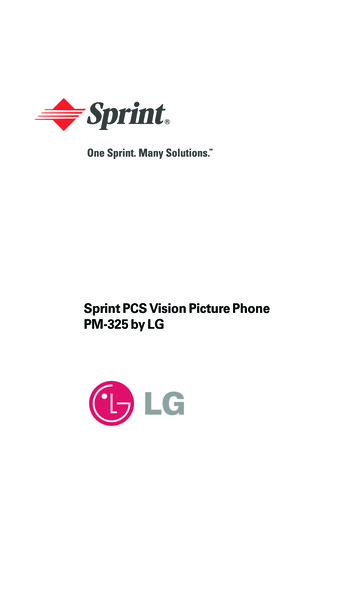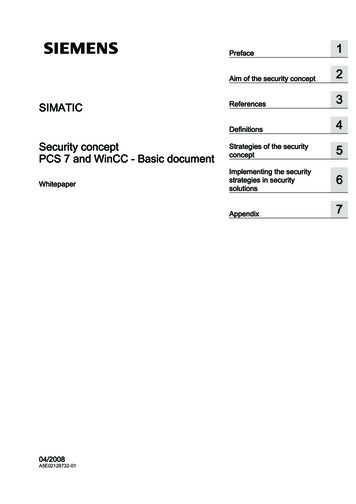
Transcription
SIMATICSecurity conceptPCS 7 and WinCC - Basic documentWhitepaperPreface1Aim of the security concept2References3Definitions4Strategies of the securityconcept5Implementing the securitystrategies in securitysolutions6Appendix04/2008A5E02128732-017
Safety instructionsThis manual contains instructions intended to ensure personal safety, as well as to protect equipment againstdamage. Instructions relating to your personal safety are indicated by a warning triangle, which does not appearwith instructions solely relating to material damage. Warning notices appear as shown below, in descending orderof hazard priority.DANGERindicates that death or severe personal injury will result if proper precautions are not taken.WARNINGindicates that death or severe personal injury may result if proper precautions are not taken.CAUTIONwith a warning triangle indicates that minor personal injury may result if proper precautions are not taken.CAUTIONwithout a warning triangle indicates that property damage may result if proper precautions are not taken.NOTICEindicates that an unwanted result or state may occur if the relevant instruction is not observed.If several hazard levels are applicable, the warning notice corresponding to the highest level is always used. If awarning notice with a warning triangle relates to the risk of personal injury, a warning relating to material damagemay also be added to that same warning notice.Qualified PersonnelThe equipment/system to which this documentation applies must always be set up and operated in accordancewith this manual. Commissioning and operation of a device/system may only be performed by qualified personnel.Qualified personnel, as used in the safety-related information in this documentation, is defined as persons whoare authorized to commission, to ground, and to tag equipment, systems and circuits in accordance withestablished safety practices and standards.Correct UsageNote the following:WARNINGThe equipment may only be used for the applications described in the catalog and the technical description, andonly in conjunction with equipment or components from other manufacturers which have been approved orrecommended by Siemens. This product can only function correctly and safely if it is transported, stored,assembled, and installed correctly, and operated and maintained as recommended.TrademarksAll product names marked with the copyright symbol are trademarks of Siemens AG. Other product names inthis document may be trademarks and third parties using these names for their own purposes may infringe uponthe rights of the trademark owners.Disclaimer of LiabilityWe have checked the content of this manual for agreement with the hardware and software described. Sincedeviations cannot be precluded entirely, we cannot guarantee full agreement. The information in this manual isreviewed regularly and any necessary corrections will be included in subsequent editions.Siemens AGAutomation and DrivesP.O. Box 48 4890327 NUREMBERGGERMANYDocument order number: A5E02128732-01 04/2008Copyright Siemens AG 2008.Modifications reserved
Contents1Preface . 51.1Validity.51.2Structure and organization of the document.51.3Required knowledge .61.4Employed products .72Aim of the security concept. 93References . 114Definitions. 1354.1Designations, terms and abbreviations.134.2Name conventions in figures and examples .20Strategies of the security concept. 235.1Defense in depth.255.2Division into security cells .285.3Role-based access control.305.4Role-based grouping and management, central and local data storage and configuration .34Security concept PCS 7 and WinCC - Basic documentWhitepaper, 04/2008, A5E02128732-013
Contents6Implementing the security strategies in security solutions. 356.16.1.16.1.26.1.36.1.4Security cells and network architecture .39High security large plants.41Secure plants .44Secure small plant .47Secure security cells connection.496.26.2.16.2.26.2.36.2.46.2.5Secure access techniques .52Secure Web publishing .53Secure integration of manufacturing control .54Protected service access .55Protected remote control through remote process control computer and remote engineering .58Secure integrated systems .596.3Hardening.606.46.4.16.4.26.4.3Management and configuration .62Managing computers and users.62Managing networks and network services.64Managing role-based operator control permissions.666.5Patch management and security updates .706.6Virus scanners .736.7Logging, audit, maintenance and asset management.766.8Security tests.777Appendix. 814Security concept PCS 7 and WinCC - Basic documentWhitepaper, 04/2008, A5E02128732-01
1Preface1.1Validity"Security Concept PCS 7 and WinCC" incrementally replaces prior documents andrecommendations "Security Concept PCS 7" und "Security Concept WinCC", both in Version1, and is valid as of WinCC V6.2 and PCS 7 V7.0 or later."Security Concept PCS 7 and WinCC" should be considered a set of recommendations andis intended to support SIMATIC customers in creating a secure network for productionplants. The recommendations are based on the latest technology, current standards and thefeatures of the employed products.1.2Structure and organization of the document"Security Concept PCS 7 and WinCC" is a document collection of requirements andrecommendations consisting of several parts: The basic document is a central guide and provides an overview of the documentcollection.This document is the basic document. It describes the general principles of the securityconcept and potential approaches for solutions. The basic document should be considered asingle entity. All additional detail documents assume the reader has read the basicdocument. The following list shows the structure of the basic document: Sections 1-4: Required information for understanding the security concept Section 5: Security strategies and their basic principles Section 6: Implementation of the security strategies for security solutions and referencesto specialized detail documents The detail documents explore specific solutions and their recommendedconfiguration in detailed form, always focusing on a particular topic or product.In the detail documents you can find detailed recommendations on important security topics,which should facilitate the implementation of the principles and solution approachespresented in the basic document.These detail documents are supplemented, updated and published separately to ensure theyare always up to date.You can find information on the "Security Concept PCS 7 and WinCC" document collectionin the Internet at the siemens.com/WW/view/en/28580051Security concept PCS 7 and WinCC - Basic documentWhitepaper, 04/2008, A5E02128732-015
Preface1.3Required knowledgeThis document collection is aimed at anyone involved in configuring, commissioning andoperating automated systems based on Siemens SIMATIC PCS 7 and SIMATIC WinCC.The basic document can also be used as an overview for decision makers or as anintroduction to the topic.The following knowledge is required for the implementation of the detail documents:6 Management of IT typical in the office environment Configuration of the employed SIMATIC products Configuration of the employed products from third parties.Security concept PCS 7 and WinCC - Basic documentWhitepaper, 04/2008, A5E02128732-01
Preface1.4Employed productsThe following products, product versions and add-ons are used in the solution approachesdescribed in this document collection: "Microsoft Windows Server 2003" (with SP1 or later) as the basic operating system forserver functions such as: Process control stations (e.g. OS server), operator control andmonitoring stations (e.g. WinCC server), Terminal Service, Active Directory domaincontroller, name services (e.g. DNS, WINS), network services (e.g. Virtual PrivateNetworks, Routing and Remote Access, Radius, Firewall), infrastructure services (e.g.certification bodies, Windows Software Update Services), and Web services. "Microsoft Windows XP" (with SP2 or later) as the basic operating system for clientfunctions such as: Process control stations (e.g. OS client), operator control andmonitoring stations (e.g. WinCC client), Terminal Service client, VPN client, Web clientand firewall client. "Microsoft Internet Security and Acceleration (MS ISA) Server 2006" as the mainfirewall system and access point to the production networks from office or intranetnetworks. "Siemens SIMATIC PCS 7 V7.0" (and later) as a special hardened process controlsystem and "Siemens SIMATIC WinCC V6.2" (and later) as a special hardened processvisualization system (operator control & monitoring system), both installed on the abovementioned Microsoft Windows Server 2003 or Microsoft Windows XP operatingsystems. "Siemens SIMATIC Logon Service" in a Windows domain environment as a combinationsecure authentication, fail-safe centralized logon and centralized user and operatormanagement or as logon server in Windows workgroups for combining centralized logonand centralized user and operator management. "SIMATIC PCS 7 OS Web Server und Client", "SIMATIC WinCC Webnavigator Serverand Client" and "SIMATIC DataMonitor Server und Clients", each used as a dedicatedWeb server, offer secure publishing via the MS ISA server as access point. "SIMATIC SCALANCE S" and "SIMATIC SCALANCE X" product families as securitymodules and network peripherals for robust Industrial Ethernet with increasedavailability, especially suited for use in industrial environments.Additional products, product versions and options may also be used, as explained in theindividual detail reports.The selection of the "Microsoft Internet Security and Acceleration (MS ISA) Server 2006"as the main firewall system and access point for the production networks is in part based onthe long-term, close and successful cooperation between Microsoft und Siemens in softwaredevelopment.The Microsoft Corp. has also been positioned in the Gardner Inc. report, "Visionaries of theSSL VPN Magic Quadrant ". This report evaluates Microsoft’s Internet Security andAcceleration Server (ISA Server) and the Microsoft developed Virtual Private Network, whichis based on the Secure Sockets Layer Protocol (Microsoft: secure sockets layer virtualprivate network (SSL VPN) )" server, both summarized in the "Intelligent ApplicationGateway (IAG)".Microsoft’s ISA Server offers a centralized and consolidated appliance for network perimeterdefense, remote access, endpoint security and application-layer protection.Security concept PCS 7 and WinCC - Basic documentWhitepaper, 04/2008, A5E02128732-017
Preface8Security concept PCS 7 and WinCC - Basic documentWhitepaper, 04/2008, A5E02128732-01
2Aim of the security conceptThe highest priority in automation is the unconditional maintenance of control overproduction and process by the operating personnel, even in the event of security threats.Preventing or limiting the spread of a security threat for plants and networks should occurwhile maintaining full operator control and monitoring of production and process.The "Security Concept PCS 7 and WinCC" is intended to ensure that only authenticatedusers can perform authorized (permitted) operations through operating option assigned tothem for authenticated devices. These operations should only be performed via defined andplanned access routes to ensure safe production or coordination of a job without danger tohumans, the environment, product, goods to be coordinated and the business of theenterprise.The "Security Concept PCS 7 and WinCC" therefore recommends the use of the latestavailable security mechanisms. This means selecting all solutions and configurations so thatthe plant manager uses all currently available security mechanisms and technologies, aswell as products from Siemens and third parties if they are required to achieve the highestpossible security of his plant. Depending on the security needs of the plant manager, theresponsibilities involved or existing implemented security mechanisms, the configurationspresented here can be implemented and scaled as shown or in adapted form. However, thisshould be carefully planned in each individual case by all involved technicians, specialists,administrators and officers. To achieve the highest possible security, adapted configurationsshould never contradict the basic principles of this security concept.This document collection is intended to facilitate the cooperation of network administrators ofcompany networks (IT administrators) and automation networks (automation engineers),allowing the exploitation of the advantages provided by the networking of process controltechnology and the data processing of other production levels without increasing securityrisks at either end.This document collection should be considered a set of recommendations and is intended tosupport SIMATIC customers in creating a secure network for production plants. Therecommendations are based on the latest technology, current standards and the features ofthe employed products.Security concept PCS 7 and WinCC - Basic documentWhitepaper, 04/2008, A5E02128732-019
Aim of the security concept10Security concept PCS 7 and WinCC - Basic documentWhitepaper, 04/2008, A5E02128732-01
3ReferencesThe following internationally recognized norms and standards are observed to ensure thatthis document collection is future-proof and includes third parties and their products in thesecurity concept:ISA - Instrumentation, Systems, and Automation Society ISA-95 "Enterprise – Control System Integration"-Part 1: "Models and Terminology"-Part 2: "Object Model Attributes"-Part 3: "Models of Manufacturing Operations Management "ISA-99 "Security Guidelines and User Resources for Industrial Automation and ControlSystems"-Part 1: "Concepts, Terminology and Models"-Part 2: "Establishing an Industrial Automation and Control Systems SecurityProgram"-Part 3: "Operating an Industrial Automation and Control System Security Program"-Part 4: "Specific Security Requirements for Industrial Automation and ControlSystems"-TR-99.00.01-2004 "Security Technologies for Manufacturing and Control Systems"-TR-99.00.02-2004 "Integrating Electronic Security into the Manufacturing andControl Systems Environment"Security concept PCS 7 and WinCC - Basic documentWhitepaper, 04/2008, A5E02128732-0111
ReferencesISO/IEC - International Organization for Standardization / International Engineering Consortium 15408 "Information Technology – Security-Techniques – Common Criteria forInformation Technology Security Evaluation" 17799 "Code of practice for information security management" 27001 "Information security management systems – Requirements" 62443 "Security for Industrial Process Measurement and Control – Network and System" 61784-4 "Profile for Secure Data Communication in Industrial Networks"NAMUR - International User Association of Automation Technology in Process Industries NA 67 "Information Protection for Process Control Systems (PCS)" NA 103 "Usage of Internet Technologies in Process Automation" NA 115 "IT-Security for Industrial Automation Systems:"FDA - Food Drug Administration FDA 21 CFR 11 "Electronic Records; Electronic Signatures"Additional future-proof measures are:12 Close consultation on the security needs of customers and plant managers (for example,through the PCS User Club or selected security-critical references plants and referencecustomers) Cooperation with independent institutions and organizations (for example, OPCFoundation, ISA, ISCI, ARC, OMAC, MsMUG, PCSF, PCSRF) Close interaction with other manufacturers and suppliers (Microsoft, for example).Security concept PCS 7 and WinCC - Basic documentWhitepaper, 04/2008, A5E02128732-01
4DefinitionsThis section defines designations, terms and abbreviations as they are used in thisdocument collection.Some terms from previous documents require updating due to work in the field ofstandardization and the need to present SIMATIC customers this document collection with auniform, internationally recognized terminology and set of concepts.Most designations, terms and abbreviations are taken from internationally recognizedstandards (e.g. ISA-95, ISA-99) or the latest documentation of the respective manufactures(see source information).4.1Designations, terms and abbreviationsPlant, automation plantA production or manufacturing system (including all distributed I/O, sensors, actuators,drives, network and software components, buildings, control cabinets, cabling, operating andadministration personnel) consisting of networked process control, process visualization,automation and engineering systemsPlant PC, plant computerA computer located in the plant manager's area of responsibility and managed there.Plant administratorA plant administrator is a user in a network who manages the plant PCs in the plantmanager's area of responsibility. The plant administrator is not necessarily an operator.User:(ISA-99): "A person or part of an organization or automatic process accessing a system withor without access permission."A real or virtual person who is logged on (for example, the user logged on to the desktop ofthe respective operating system or an automatic desktop logon).Security concept PCS 7 and WinCC - Basic documentWhitepaper, 04/2008, A5E02128732-0113
DefinitionsOperator, plant operatorAn operator (or plant operator) is a real person logged on to the automation plant. Thisperson is trained and authorized to operate this plant (for example, the operator logged on inPCS 7).Computer nameThe computer name is one way of identifying a computer in the network. It corresponds tothe host part of the FQDN (Fully Qualified Domain Name), if a DNS assignment has beenmade (DNS suffix assignment). The computer name may match the NetBIOS name of thecomputer, if the computer name does not exceed 15 characters and both names have notbeen intentionally selected to differ.DCS, distributed control system(ISA-99): "A type of control system in which the system elements are distributed butoperated as coupled. In general, the time constants of the coupling are substantially lessthan those for SCADA systems.Note:Distributed process control systems are usually used in the context of continuous processes,such as the generation of electrical energy, refining of oil and gas, production of chemicals orpharmaceuticals and manufacture of paper; they are also used in discrete processes suchas manufacturing, packaging and warehousing of automobiles and other goods."Domain(ISA-99): "Environment or context which is defined by a security policy, security model orsecurity architecture and includes a group of system resources as well as the correspondinggroup of system entities that have permission to access these resources."(Windows): Logical group of computers on which a version of the Microsoft Windowsoperating system is run and which uses a central, common directory database (referred to asActive Directory as of Windows 2000). The Active Directory contains the user accounts andsecurity information for the resources in this domain. Each person who uses the computerswithin a domain is assigned a unique user account or unique user name. This account canbe assigned access permissions to resources within the domain.(Windows): A model for managing local Windows networks, corresponds to a local securityzone with centralized management of resources and represents an administrative border.14Security concept PCS 7 and WinCC - Basic documentWhitepaper, 04/2008, A5E02128732-01
DefinitionsDomain controller (DC)(Windows): A domain contains the directory of computers that are configured as "domaincontrollers". A domain controller is a server that manages all security-related aspects of theindividual users and domain interactions. The security services and administration servicesare centrally managed on this server.(Windows): A domain controller is a server for centralized authentication and authorization ofcomputers and users in a computer network.Firewall(ISA-99): "Belongs to the connection between networks and restricts data traffic betweenconnected networks.Note:A firewall can be either an application, which is installed for general purposes on anappropriate computer, or a dedicated platform (appliance), which forwards or discardspackets in a network. The firewall typically serves to define zone borders. A firewall usuallyworks with restriction rules, which allow only specific ports to be opened."Firewall typesServe to better distinguish tasks and application locations in this document collection: Front-end firewallA front-end firewall protects the perimeter. Only uniquely identified, real persons haveaccess via verifiable communication (application filter). Uniquely identified and trusteddevices may be permitted access (e.g. via IPSec) by declaring exceptions. Back-end firewallA back-end firewall protects the PCN production network from the perimeter and othertrusted networks (e.g. MON). The back-end firewall must be realized as a performancebased solution for uniquely identified, trusted devices. Three-homed firewallA three-homed firewall is a combination front-end and back-end firewall, with a separate"minimal perimeter" for scalable security solutions. Access point firewall(Special case) An access point firewall is exclusively used for maintenance tasks,permitting access to a security cell, which otherwise would require no connection (e.g. toMES).Security concept PCS 7 and WinCC - Basic documentWhitepaper, 04/2008, A5E02128732-0115
DefinitionsControl center;(ISA-99): "Central location at which a group of resources are operated.Note:In an industrial infrastructure, one or more control centers usually serve to monitor andcoordinate operating procedures. These are usually connected via a WAN (Wide AreaNetwork) in complex plants with several control centers, for example, a fail-safe controlcenter at another location. A control center contains the SCADA host computer andassociated display device for operators, as well as supporting information systems, such asan archive server."Network namesNetwork names facilitate the assignment of groups of networked systems with similar areasof application in this document collection, e.g.:16 ECN - Enterprise Control (Systems) NetworksDesignation for a network as component of a security cell or security zone, whichcontains the ERP (Enterprise Resource Planning) system. This is usually the samenetwork cloud as the so-called office network. MON – Manufacturing Operations NetworkDesignation for a network as component of a security cell or security zone, whichcontains the MES (Manufacturing Execution Systems). This is usually the same networkcloud as the so-called office network or a special network or part of a production controlnetwork (PCN). The service personnel also use this network in many cases. PCN – Process Control (Systems) NetworkDesignation for a network as component of a security cell or security zone of the plant,which contains the PCS (Process Control Systems), DCS (Distributed Control Systems)or SCADA (Supervisory Control and Data Acquisition) systems. This is always a socalled plant, terminal or HMI network. This should be a special and separate network.The service personnel also use this network in many cases. CSN – Control Systems NetworkDesignation for a network as component of a security cell or security zone of the plant,which contains the automation systems. The PCS or DCS or SCADA server systems arealso connected to the CSN to be able to establish contact to the automation systems.CSN involves the so-called plant network or the so-called plant bus. It should be aspecial and separate network that is not used for data communication betweencomputers and whose bandwidth and availability are reserved for the automationsystems. FDN – Field Device NetworkDesignation for a network as component of a security cell or security zone of the plant inwhich only automation systems and field devices are connected to one another. Perimeter – perimeter networkDesignation for a separate and firewall-protected network used for policy-based datacommunication by means of perimeter techniques.Security concept PCS 7 and WinCC - Basic documentWhitepaper, 04/2008, A5E02128732-01
DefinitionsPerimeter network, perimeter, demilitarized zone (DMZ)(ISA-99): "Segment of the perimeter network, which is logically located between internal andexternal networks"Note:The purpose of the so-called demilitarized zone on the one hand is to enforce the policy ofthe internal network for information exchange to the outside world as well as to restrictaccess of non-trusted external sources to public information only, and, on the other hand,thereby shield the internal network from attack from the outside world.Note: In the context of industrial automation and control systems, "internal network" usuallymeans the network or segment on which the protective mechanisms primarily concentrate.For example a process control network is considered an "internal network" if it is connectedto an "external" enterprise network."Process control network (general)(ISA-99): "Networks which are normally connected to time-critical equipment for controllingphysical processes (see "Secure network").NOTE: The process control network can be divided into zones and there may be severalseparate process control networks within a company or location".Process control equipment (general)(ISA-99):" A category that includes distributed process control systems, programmable logiccontrollers, SCADA systems, dedicated consoles for HMI interfaces, as well as sensorequipment and control instruments in the field or managing and controlling the process.Note: The term also encompasses Fieldbus networks, in which control logic and controlalgorithms are executed on intelligent electronic devices that coordinate their actions".Security concept PCS 7 and WinCC - Basic documentWhitepaper, 04/2008, A5E02128732-0117
DefinitionsIndustrial automation and control systems (IACS) (general)(ISA-99): "The term encompasses control systems for use in m
Security concept PCS 7 and WinCC - Basic document Whitepaper, 04/2008, A5E02128732-01 5 1 Preface 1.1 Validity "Security Concept PCS 7 and WinCC" incrementally replaces prior documents and recommendations "Security Concept PCS 7" und "Security Concept WinCC", both in Version 1, and is valid as of WinCC V6.2 and PCS 7 V7.0 or later.
